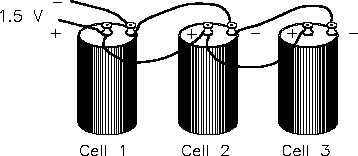Batteries
BATTERY OPERATIONS
Parallel Cells
Figure 8 Cells Connected in Parallel
Cells
connected
in
parallel
(Figure 8), give the battery a
greater current capacity.
When
cells are connected in parallel, all
the
positive
terminals
are
connected together, and all the
negative terminals are connected
together. The total voltage output
of a battery connected in parallel
is the same as that of a single cell.
Cells connected in parallel have
the same effect as increasing the
size
of
the
electrodes
and
electrolyte in a single cell. The
advantage of connecting cells in
parallel is that it will increase the
current-carrying capability of the
battery.
Primary Cell
Cells that cannot be returned to good condition, or recharged after their voltage output has
dropped to a value that is not usable, are called primary cells. Dry cells that are used in
flashlights and transistor radios (e.g., AA cells, C cells) are examples of primary cells.
Secondary Cells
Cells that can be recharged to nearly their original condition are called secondary cells. The
most common example of a secondary, or rechargeable cell, is the lead-acid automobile battery.
Capacity
The capacity of a storage battery determines how long the storage battery will operate at a certain
discharge rate and is rated in ampere-hours. For example, a 120 ampere-hour battery must be
recharged after 12 hours if the discharge rate is 10 amps.
Rev. 0
Page 11
ES-04



